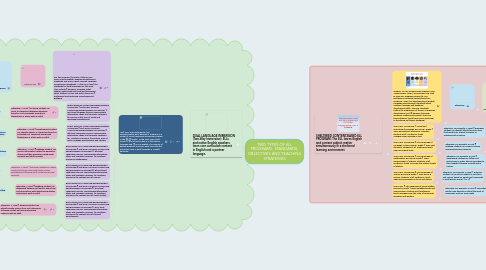
1. DUAL LANGUAGE IMMERSION (Two-Way Immersion): ELLs and native English speakers learn core curriculum content in English and a partner language.
1.1. I will use a Pre-Kindergarten (PK) Spanish-English Early Education program as a model of a Dual Language Immersion Program. In the 90:10 model, in the early years (until Grade 2) 90% of instruction is in the partner language and 10% is in English. The amount of English gradually increases each year until the instruction time in each language is equally balanced.
1.1.1. For this program, the State of Illinois uses WIDA's Early English Language Development Standards and WIDA's Early Spanish Language Development Standards. At the pre-K level, the standards for both languages are the same. They include 2 domains: receptive (what children understand and read) and expressive (what children can say and write); there are 3 proficiency levels Entering, Developing and Bridging
1.1.1.1. OBJECTIVES
1.1.1.1.1. TEACHING STATEGIES
1.1.2. EARLY ENGLISH LANGUAGE DEVELOPMENT STANDARD 1 and EARLY SPANISH LANGUAGE DEVELOPMENT STANDARD 1: ELLs/Dual language learners communicate information, ideas, and concepts necessary for success in the area of Social and Emotional Development
1.1.2.1. Objective: A Level 1 Entering Student can point to characters displaying emotions based on oral commands using book illustrations or photo with an adult
1.1.2.1.1. TEACHING STRATEGY:Dramatization, gestures; use visual aids
1.1.3. EARLY ENGLISH LANGUAGE DEVELOPMENT STANDARD 2 and EARLY SPANISH LANGUAGE DEVELOPMENT STANDARD 2: Ells/Dual Language Learners communicate information, ideas, and concepts necessary for academic success in the content area of Early Language Development and Literacy
1.1.3.1. Objective: A Level 3 Development Student can identify objects or characters based on extended oral commands using book illustrations or photo with an adult
1.1.3.1.1. TEACHING STRATEGY: Culturally-responsive instruction which include books and songs
1.1.4. EARLY ENGLISH LANGUAGE DEVELOPMENT STANDARD 3 and EARLY SPANISH LANGUAGE DEVELOPMENT STANDARD 3: Ells/Dual Language Learners communicate information, ideas, and concepts necessary for academic success in Mathematics.
1.1.4.1. Objective: A Level 5 Bridging Student can recount information related to geometric shapes and their properties using visual supports and adult prompts
1.1.4.1.1. TEACHING STRATEGY: Use manipulatives and hands-on activities
1.1.5. EARLY ENGLISH LANGUAGE DEVELOPMENT STANDARD 4 and EARLY SPANISH LANGUAGE DEVELOPMENT STANDARD 4: Ells and Dual Language Learners communicate information, ideas, and concepts necessary for academic success in the content area of Science
1.1.5.1. Objective: A Level 1 Entering Student can repeat words and phrases associated with science investigation following adult model using visual supports
1.1.5.1.1. TEACHING STRATEGY: Choral drills, visual aids, read alouds
1.1.6. EARLY ENGLISH LANGUAGE DEVELOPMENT STANDARD 5 and EARLY SPANISH LANGUAGE DEVELOPMENT STANDARD 5: ELLs/Dual Language Learners communicate information, ideas, and concepts necessary for academic success in the content area of Social Studies.
1.1.6.1. Objective: A Level 5 Bridging Student can distinguish between self and/or peers from oral descriptions with details using photos and pictures with an adult
1.1.6.1.1. TEACHING STRATEGY: Modeling, scaffolding
1.1.7. EARLY ENGLISH LANGUAGE DEVELOPMENT STANDARD 6 and EARLY SPANISH LANGUAGE DEVELOPMENT STANDARD 6: ELLs/ Dual Language Learners communicate information, ideas, and concepts necessary for academic success in the content area of Physical Development.
1.1.7.1. Objective: A Level 1 Entering Student can identify simple actions from oral statements following models and using interactive supports with an adult
1.1.7.1.1. TEACHING STRATEGY: Total Physical Response; learning through play
2. SHELTERED CONTENT-BASED ELL PROGRAM: The ELL learns English and content subject matter simultaneously in a sheltered learning environment
2.1. WORLD -CLASS INSTRUCTION DESIGN AND ASSESSMENT (WIDA) STANDARDS are used in many ELL programs across the USA including in sheltered content-based ELL programs. WIDA has developed ELD (English Language Development) standards which combine language and academic development skills. The ELD standards outline the progression of the ELL's language development in all 4 domains (listening, speaking, reading and writing). There are five proficiency levels from novice (Entering) to bordering on fluency (Bridging).
2.1.1. Objectives
2.1.1.1. TEACHING STRATEGIES
2.2. WIDA ELD STANDARD 1: Social and Instructional Language EXAMPLE:. Grade 1 Topic Recreational Classroom Activities, students at all proficiency levels UNDERSTAND meaning in text
2.2.1. Objective: For example, a Level 2 Emerging Student can identify labeled pictures from illustrated texts related to games or activities with a partner
2.2.1.1. TEACHING STRATEGY: Use hands-on activities; provide both oral and written directions
2.3. WIDA ELD STANDARD 2: The Language of Language Arts EXAMPLE: Grade 1 Topic Text elements, students at all proficiency levels CREATE original texts
2.3.1. Objective: For example, a Level 5 Bridging Student can compose stories incorporating text elements
2.3.1.1. TEACHING STRATEGY: Use interactive writing activities; have students make presentations using visual aids; peer editing
2.4. WIDA ELD STANDARD 3: The Language of Mathematics EXAMPLE: Grade 1 Topic Measurement of Objects, students at all proficiency levels ANALYZE the relative length of objects-
2.4.1. Objective: For example, a Level 3 Developing Student can follow oral instructions to order objects according to their lengths following a model with a partner
2.4.1.1. TEACHING STRATEGY: Use manipulatives and real life examples; teach vocabulary directly
2.5. WIDA ELD STANDARD 4: The Language of Science EXAMPLE Grade 1 Topic Force & Motion, students at all proficiency levels CREATE experiments on force and motion
2.5.1. Objective: For example, a Level 1 Entering Student can construct models to test force and motion based on simple oral commands in small groups using L1 or L2
2.5.1.1. TEACHING STRATEGY: Use visuals to explain directions; label classroom objects; use simple language
2.6. WIDA ELD 5: The Language of Social Studies EXAMPLE Grade 1 Topic Neighborhoods and Communities, students at all proficiency levels UNDERSTAND the roles of community members and workers
2.6.1. Objective: For Example, a Level 4 Expanding Student can describe in detail the work of community workers using realia
2.6.1.1. TEACHING STRATEGY: Use graphic organizers to represent concepts and facts; model accurate language by rephrasing
